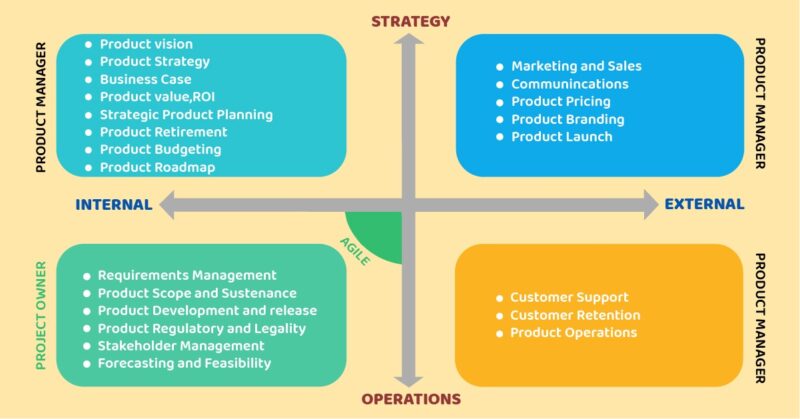
Sumeet Madan
With a remarkable 18-year tenure in software engineering, agile training, coaching, and consulting,... Read more

With a remarkable 18-year tenure in software engineering, agile training, coaching, and consulting,... Read more

Straightforwardly if I have to explain Product Management, then I would say, "The activities performed throughout the Product Lifecycle is the Product Management." And the Product Manager is accountable for those activities.
Let's dive into understanding a few roles that have created a few confusions in Agile Product Management.
To understand these roles, we first need to understand Product Management, and for that, we may need to understand the Product Life cycle. So let's start with the Product Life Cycle first.
What are the Product and its lifecycle? The Scrum Guide, November 2020
"A product is a vehicle to deliver value. It has a clear boundary, known stakeholders, well-defined users, or customers. A product could be a service, a physical product, or something more abstract." - merriam-webster.com 1) Something produced
2) Something (such as a service) that is marketed or sold as a commodity.
AND
AND
Test your knowledge and expertise to enhance your effectiveness in product management. Elevate your capabilities and excel in driving product success.
Explore Practice Test.
"The term product life cycle refers to the length of time a product is introduced to consumers into the market until the product is removed from the shelves." - Investopedia A product life cycle has four stages: introduction, growth, maturity, and decline. These are used by marketing & management professionals to help determine ad schedules, pricing, expansion to new product markets, packaging redesign and more.
This method of support is known as product management. They can also help determine when the newer products are ready to push older ones from the market. Many activities happen throughout the Product lifecycle that can be put into the Product Management Quadrant that mentions the Strategic and Operational activities, and how they are mapped in the Organization.
Many activities happen throughout the Product lifecycle that can be put into the Product Management Quadrant that mentions the Strategic and Operational activities, and how they are mapped in the Organization.

Mainly, different roles in the Organization manage many of these activities. But this often looks like (from the traditional ways of working) as:

It is evident that the Product Manager role is more aligned with strategy and market-facing, wherein the Project Manager is more aligned with the execution.
"Product managers are strategically responsible for driving the products and plans, whereas project managers are responsible for the execution of those development plans."
Both the roles work closely together on the initiatives, but the responsibilities differentiate them in most cases.
Now that we understand the responsibilities of both these roles from the Product Management perspective, where does the Product Owner fit in Agile Product Management?
Let's re-look the Product Management Quadrant, and this time with the Agile as a Product Development approach.

Looking at the picture, please don't confuse that the Product Owner is the same as the Project Manager or replaces the Project Manager in the Agile ways of Work. These roles are from two different Worlds.
Project Manager as a role comes from PMI and PRINCE2, whereas Product Owner is a role defined in Scrum (A foundational framework for Agile).
In Scrum Context, Scrum doesn't have the role of the Project Manager, and Waterfall and PRINCE2 don't have the role of a Product Owner. However, Scrum not having the Project Manager's role doesn't mean the Project Management is also not required. The delivery of valuable increment deals with the scope, risk, release, and stakeholder management.
The process and people are still involved in this and also delivery of quality Increment. Although the business part of the project management activities falls under the role of the Product Owner, the process, people enablement, and creating high-performing scrum teams is on Scrum Master's plate, and the quality of delivery is with Developers.
Should the Product Owner choose to delegate the business part of this, then the famous role that comes into play is the Business Analyst. The Business Analyst again is not a formal role in Scrum. Hence, they would be considered as the Developer in the Scrum Team for their active contribution in helping to develop the valuable Product.
With a remarkable 18-year tenure in software engineering, agile training, coaching, and consulting, Sumeet's expertise is unparalleled. As a certified Professional Scrum Trainer (PST) from Scrum.org and a distinguished SAFe® Practice Consultant (SPC), Sumeet brings a wealth of knowledge and skill to every project, making a lasting impact on organizations seeking to embrace Agile methodologies.
WhatsApp Us
Sumeet is an excellent coach and can relate the subject to the day-to-day work we do. That makes our understanding easie...
I attended PSPO Training by Sumeet Madan last wakened and I must say it has been the best training ever. He did not open...

I had recently attended PSPO training with Sumeet Madan and it was fantastic! His expertise in Agile product ownership i...

Excellent way of providing the training by Preeth. Scenario based teaching approach makes it extremely easy to learn and...

I recently took the ICP-ENT (Enterprise Agile Coaching) training with an online course. The customer service was great a...

We will get back to you soon!
For a detailed enquiry, please write to us at devops@agilemania.com
We will get back to you soon!
For a detailed enquiry, please write to us at devops@agilemania.com


